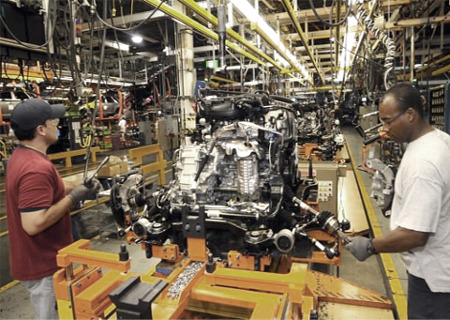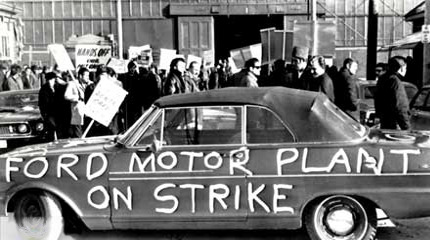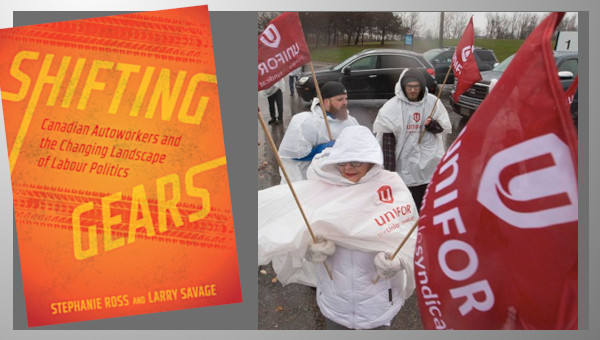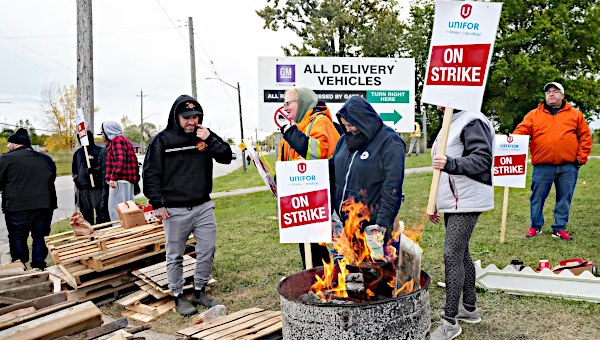Different Ways of Making History1
Canadian autoworkers have long been pace setters in the Canadian labour movement and as soon as its most recent agreement with General Motors was ratified, Unifor (the successor in 2013 after the merger of CAW and CEP) laid claim to that agreement’s ‘historic’ status. It has now also been ratified by the Chrysler workers, but at the Ford assembly plant in Oakville – now the largest auto facility in the country – it’s pretty hard to find any enthusiasm for the outcome of this latest bargaining round. If this agreement is indeed historic, it may be so in a sense quite different than the leadership’s bravado declaration intended.
Background: The Cancer of Two-Tier Wages
 When the financial crisis of 2007-9 brought GM and Chrysler to their knees, it was hardly surprising that the pressure would intensify on workers. This came not only from the economics of the crisis and threats from the companies, but also from the U.S. and Canadian governments. As they intervened to save the companies with public monies, they notably added further pressures on the union and its members by explicitly demanding autoworkers ‘do their share’ to lower corporate costs. (Ford, the third of the auto triumvirate, had enough of a cash hoard to avoid seeking state help, but was no less anxious to exploit the crisis in bargaining with its unions).
When the financial crisis of 2007-9 brought GM and Chrysler to their knees, it was hardly surprising that the pressure would intensify on workers. This came not only from the economics of the crisis and threats from the companies, but also from the U.S. and Canadian governments. As they intervened to save the companies with public monies, they notably added further pressures on the union and its members by explicitly demanding autoworkers ‘do their share’ to lower corporate costs. (Ford, the third of the auto triumvirate, had enough of a cash hoard to avoid seeking state help, but was no less anxious to exploit the crisis in bargaining with its unions).
Such working class concessions did not of course start with this latest crisis. In the auto sector, the American union (United Automobile Workers – UAW) had, since the end of the 1970s, repeatedly rationalized wage restraint or concessions as ‘trade-offs’ for jobs. That the job security never really materialized rarely led to that logic being challenged; rather, it only resulted in hunkering down to ever more desperate cycles of concessions to save the remaining jobs which, by virtue of decent-paying jobs disappearing throughout the economy, now seemed even more valuable. In contrast, the Canadian section of the union had over most of that same period strongly opposed that illusory trade off – to the point of breaking their institutional links with its American parent in the mid-80s to establish the CAW.
But stubbornness itself was always an incomplete response to the attacks on working people. By the early years of the new millennium the CAW too was slipping toward greater accommodation to corporate power. The marked rise in the Canadian dollar – an outcome of both the Tar Sands exports and an economy not doing as badly as the U.S. during the crisis – compounded the pressures on autoworkers. For years the Canadian dollar had bounced around $0.80 (US); as the Canadian dollar approached and even occasionally exceeded parity with the U.S. dollar, the competitive advantages of being paid in lower Canadian funds faded.
Going into the latest bargaining round, Canadian autoworkers had seen both their base rates frozen and their cost-of living suspended since 2008. The result was that in inflation-adjusted terms, their hourly pay in the fall of 2016 was about 16% below what it was in the summer of 2008. Nor was that the only concession. The auto companies, smelling blood, also demanded a radical change in the compensation of new hires, calling for them to be paid substantially less and their defined pension benefits to be converted to benefits dependent on contribution and returns on investments.
The push for a two-tier wage structure – workers doing the exact same work getting different rates of pay over and above a short initial adjustment period – first significantly erupted in the U.S. in the early 80s. It cropped up in the airline industry, which was struggling with the impact of deregulation, and quickly flowed into aerospace. With corporations demanding concessions and the workforce stubbornly resisting, an ‘innovative’ solution emerged: apply the concessions to workers not yet in the industry and therefore not voting on the contracts.
The head of the Canadian section of the UAW, Bob White, called two-tier wages a ‘cancer’ that had to be stopped ‘before it spread into Canada’ [Bob White, Hard Bargains, p.367]. When, in 1984, McDonnell-Douglas achieved a two-tier structure in the U.S. and tried to bring it across the border, the Canadians, backed by a strike threat, did successfully block this import. The union did however accept a lower hiring rate of 85%, though this was limited to an 18 month grow-in. The hiring rate structure remained unchanged over the following decades, but during the crisis of 2008-9, it was revived as the easy way to shift the burden of concessions (or at least a significant part of them) to another generation.
In 2008 the starting rate was lowered to 70% and the grow-in increased to three years. In the Ford ratification brochure highlighting the new agreement, the President of the CAW at the time insisted that this remained consistent with the principles of “solidarity between generations, linking today’s union members with both retirees and the generation that comes after us. Equal pay for equal work. And a refusal to subsidize, out of our own pockets, a crisis that is not remotely our fault.” But a door had been opened and the corporations, taking advantage of the fear occasioned by the crisis, pushed on relentlessly to gain acceptance for re-opening the contract in 2009 and increasing the grow-in to 6 years.
In 2012, the roof caved in on the new-hire structure. The 2012 agreement brought an unambiguously qualitative change in the practice of equal pay for doing the same work. The grow-in was extended to ten years and new hires started at 60% of the base year with the movement through the grid frozen for three years. After the 10th year, new hires got to where the base was when they hired in. As for catching up to any increases the ‘traditional’ workers got over that interim period, this would occur in incremental annual steps after that 10th year. Furthermore, new hires would also be discriminated against in their retirement years; rather than defined benefit pensions they would have a ’hybrid’ plan that combined elements of both defined and contributory pensions plans.
Changing Course?
Soon after the signing of that definitive four-year agreement of 2012, the crisis in auto sales abruptly ended. Profits, especially at GM and Ford, rose and stayed exceptionally high. As the 2016 bargaining round approached, the lower Canadian health care costs and the fall of the Canadian dollar to the $0.75 (US) range left the Canadians with a significant cost advantage relative to the USA. As the Windsor Star noted, in U.S. dollars, the all-in labour costs at the Detroit Three Canadian plants were “about $50 an hour compared to $54 in the U.S.” For new hires this was “about $30 an hour compared to $42 for new hires at U.S. plants.” [Windsor Star, June 28, 2015].
This changed context seemed to suggest that a reversal of the past concessions would surely come, and interviewed on the eve of his election as the first president of Unifor, Jerry Dias indicated as much. Dias “predicted that a major ‘pushback’ and more labour unrest is coming” and added – ironically in terms of his later defense of the union’s new-hire structure – that “young people will lead that charge because I see them being very militant. … They won’t accept the norm anymore.” [Toronto Star, August 30, 2013].
As the UAW went into negotiations in the summer of 2015, that readiness to correct the concessions of the recent past was reconfirmed: “This isn’t 2008 anymore,” Dias declared. “The auto companies are doing incredibly well and it’s time workers shared in the success. Heaven knows we shared during the troubled times.” [Windsor Star, above]. Dias went on to express his expectations of the U.S. bargaining round:
I am pulling for [UAW president] Dennis [Williams] because his members deserve a share in the success of their companies. … There’s no question in my mind Dennis is determined to make incredible inroads in the two-tier wage system. He understands clearly the incredible inequity that exists. He also understands that his tier-one members haven’t had a pay increase in eight years, which is unacceptable.
And yet for some reason that advice and the hopes behind it didn’t apply to Canada. Far from challenging and reversing the concessions made, the union consolidated them. Though wages did rise by 4% over the four-year agreement (the UAW got a marginally better 6% raise and significant profit-sharing sums), the continued suspension of the cost-of-living allowance meant that after adjustment for inflation, real wages would continue to fall. By the agreement’s end in 2020, the loss will approach 20%. Since pensioners also lost their cost-of-living, they too will continue to see their incomes erode.
It might have been thought that such restraint was the most the companies would expect given the strong revival of the companies, the earlier sacrifices of the workers, and the favorable costs in Canada. Surely, this was the moment to ease the new-hire penalty? But having finally gotten the new hire rate, the companies weren’t about to willingly modify it. And as a bulletin to the Ford and Chrysler workers following GM’s ratification made clear, the union leadership wasn’t up to challenging the corporations on this score. Unifor meekly let the companies define what was possible, offering only this rather lame ‘explanation’:
“Unifor negotiators also pursued with all three companies the idea of shortening the current 10-year grow-in period. In the eyes of U.S.-based CEOs, the ten-year grow-in timetable was crucial for attracting new investment and new product north of the border. On this point the companies were unanimous and aggressive in rejecting changes to the progression length.” [Special Information Bulletin for Unifor Leadership at Fiat-Chrysler and Ford, September, 2016].
The agreement included some tinkering in the new-hire system – improvements in the grid were no longer frozen for three years – but the core structure remained unchanged. This did not even match the very modest change in the U.S. from a 10-year grow-in to an 8-year grow in – which itself only occurred after the Chrysler workers in the U.S. rejected their tentative agreement.
Union information sheets claimed the changes made in the new hire rate would give new hires ‘thousands of dollars’ but that only brought to mind a robber taking your money and car, returning a fiver for a coffee and bus fare, then waiting for you to express your gratitude for his generosity. The point is that even after the adjustment in the new-hire rate, a new hire under the new agreement would lose some $200,000 relative to the pre-2008 hiring-in structure (i.e. 85% with an 18 month grow-in) and about $90,000 relative to the 2009 concession of moving to 70% over 6 years.
Here again, it might have seemed that with wage increases below the rate of inflation, no improvements in pensions, and the basic acceptance of the two-tier structure for new hires, the Company had little basis for adding more takeaways to the new hires. Wrong again. When companies see weakness it only invites them to demand more. In this case, the defined benefit portion of the ‘hybrid’ pension was ended; new hires would henceforth only have a contributory pension benefit plan. This permanent two-tier system in retirement would mean that the pensions of new hires would be lower than ‘traditional’ workers; the pension amounts would be more uncertain with the risks shifted from the companies to the workers; and in contrast to other union members, the new hires would have to pay 4%-5% of their wages out of pocket for this inferior plan.
Selling the Agreement
Unifor’s leadership has dismissed criticism of the agreement worked out at GM and now ratified at Fiat-Chrysler (FCA) as the easy pontifications of outsiders with ‘no skin in the game’. This is an old expedient for avoiding debate, but in this case it also dismisses the extent of dissatisfaction within the union.
The 65% ratification at GM was the lowest in history (since the 1984 negotiations which led to the formation of the CAW, ratifications have averaged 84%). At GM’s St. Catharine’s engine plant, there have been discussions about recalling the local bargaining committee. At CAMI – the ‘little sister’ at GM that stands outside the Master agreement but is very much affected by it – the local leadership took the unprecedented step of distributing an angry leaflet opposing the agreement. Most significant, as noted earlier the leadership in the Ford Oakville plant, very much backed by its members is intending to reject the pattern.
By defending and so aggressively overselling the achievements of this contract, the union leadership came to depend on the same contradictory arguments that it once decried when used by the UAW. Those arguments, the CAW emphasized at the time, had ensnared the union into making the case for the companies rather than defending its members. So Unifor bulletins now deny that the new-hire structure is effectively a two-tier structure even though almost everyone clearly understands it to be so. Or the union argues that two-tiers are not really that bad since its ‘better than not having a job’.
National and local leaders praise pattern bargaining as equalizing conditions across the Detroit Three – “If I’m working on the line, I’m going to make the same money regardless of which one of the Detroit Three (it is)” [Detroit News, October 6, 2015] – but they remarkably set aside inequalities among two people doing the same work in one plant. In attacking the Oakville workers for not accepting the pattern as an unchallengeable given, they too readily forget that the solidarity behind pattern bargaining was introduced to make progress, not prevent workers from fighting their employers. They forget as well that the very formation of the CAW was rooted in the Canadian section of the UAW refusing to follow the American pattern it had for so long automatically accepted.
In justifying the phasing out of defined benefit plans, Unifor does raise the legitimate question of whether private companies can in fact guarantee defined benefit plans in the future. This does need deeper discussion along with the alternative of a radically transformed universal pension plan that parallels universal health care. But to simply give up on such plans in bargaining betrays those still trying to hang on to their plans. Moreover, it tends to lower popular expectations of what is possible for senior citizens in a rich society, and correspondingly reduces pressure on governments to actually move toward such pensions. Giving up defined benefit plans without a struggle is hardly the way to place on the agenda the larger, difficult question of the future of decent pensions for all.
The Trap of Bargaining Investment
Underlying all this is the strategic trap Unifor fell into by effectively making investment the primary and, as the Oakville local rightly noted, the only issue in bargaining. It is one thing to join with other workers in a political struggle to address investment and jobs. But making it into the principle demand moves bargaining to a terrain in which the corporations call the shots and the union is left to more or less ask “What can workers do for you to ‘buy’ new investment?.”
This point cannot be underestimated. Once on this track, why should any company ever make an announcement about planned investments before first holding it back and asserting its conditionality on more restraint/concessions from workers and subsidies from governments? Investments that would have been made anyways now become corporate bargaining chips – and worst of all, this is not temporary. It will never end. In 2020, corporate profits will again be brushed aside. If Canadian labour costs are in fact lower, this will again be said to be irrelevant; if workers have issues to correct – tough. The blackmail, once given into, works its magic indefinitely.
 And that too is not the end of the problem. Even when corporations ‘give in’ and make promises, they sometimes honestly can’t meet them for reasons beyond their control, given that the economy as a whole is unplanned and future markets and competition are so uncertain (though the concessions made by workers are of course firmly tied down). Other times, corporations, in the pursuit of their own goals, simply ignore those promises because they can – there is no mechanism to enforce them. And sometimes the fine print in the promises is itself rather iffy. The most recent investment announcements at GM and Chrysler are certainly welcome, but aside from the possibility that some of this may have been coming anyways, unconfirmed reports suggest that GM’s promises in Oshawa and St. Catharines involve Canada getting ‘overflow’ investment, not ‘primary’ investments. If the market is there, the investments will come; and if it isn’t, cutbacks will first occur in Canada.
And that too is not the end of the problem. Even when corporations ‘give in’ and make promises, they sometimes honestly can’t meet them for reasons beyond their control, given that the economy as a whole is unplanned and future markets and competition are so uncertain (though the concessions made by workers are of course firmly tied down). Other times, corporations, in the pursuit of their own goals, simply ignore those promises because they can – there is no mechanism to enforce them. And sometimes the fine print in the promises is itself rather iffy. The most recent investment announcements at GM and Chrysler are certainly welcome, but aside from the possibility that some of this may have been coming anyways, unconfirmed reports suggest that GM’s promises in Oshawa and St. Catharines involve Canada getting ‘overflow’ investment, not ‘primary’ investments. If the market is there, the investments will come; and if it isn’t, cutbacks will first occur in Canada.
The experience in dealing with such promises is littered with false promises that the press and the union itself steadfastly ignores. When the UAW began to trade restraint for jobs in the late 70s, its U.S. Detroit Three membership stood at approximately 750,000. Today, after all those ‘trade-offs’ for jobs, U.S. membership stands at under 120,000 – a loss of well over 600,000 jobs or close to 85% of that earlier number. In Canada, the collapse was not quite as bad but still stunning: from about 70,000 to a current 23,000 – a loss of about 2/3 of the jobs.
Desperate to defend its virtual total emphasis on bargaining investment commitments (and perhaps also to isolate the Oakville local), Unifor has pointed to the Oakville plant as an example, arguing that the very major investments it got in 2013 were the result of the new-hire structure negotiated in 2012. But this is dishonest at worst, misleading at best. As the president of the Oakville local has pointed out, the commitment for these investments was actually made in 2009, before the 60%, 10-year phase-in came into place. The 2009 highlights brochure, produced by the national union, confirms this: it proudly proclaims that Ford has made a commitment to the “allocation of new-generation products to Oakville based on a new global vehicle platform during the business plan period.”
The point is that bargaining over jobs ends up giving workers neither decent standards for their work nor job security. It diverts attention from the broader, complex question of what needs to be done now that private corporations clearly aren’t up to improving working people’s lives and making them more secure. And it tends to demoralize workers and weaken unions so that they’re no longer a force capable of addressing those larger issues and leading progressive change.
Conclusion: Making History?
It would be unfair to blame the weaknesses in this current agreement solely on the present leadership of Unifor. The die was cast earlier under former leaderships. Moreover, the crisis in labour is clearly much deeper than recent trends in auto. When the turn to a new aggressiveness against working classes became the norm across capitalist countries, the responses of the trade union movement were remarkably limited.
One response assumed that nothing had fundamentally changed, that what was going on was temporary, that it would correct itself as the business cycle turned or as new politicians came into office with new policies. And so the best thing to do was to muddle through. Another was to find a technical solution in growth through union mergers, thinking that as with corporate mergers, ‘size’ would be their salvation. A third acknowledged the significance of the changes going on but was overwhelmed by them. These changes were seen as inevitable, leaving little to do but to accommodate to them – make concessions to hang on to what you had and make deals with the corporations you formerly distrusted and the politicians you formerly despised. Either way, unions faded as a vehicle for expressing and leading popular discontent What these so-called alternatives all had in common was their refusal to learn the lessons of the past and grasp that only mobilization and organizing, not muddling through, size, nor deals dressed in militant rhetoric could save the labour movement.
The criticism of Unifor’s current direction lies in its response to the deep economic crisis in auto being over; the auto companies now rolling in money; Canada currently sitting in an advantageous competitive position; and a new generation of workers looking to see what unions were really about. The time seemed ripe to lead a reversal in the labour movement’s trajectory – but this was not even tried. That failure defines what was in fact ‘historic’ about the 2016 agreement: it was not the highly overblown claims of the union’s achievements, but the confirmation of the end of the union’s leadership legacy within the labour and social movements.
The story may, however, not be over. The Ford workers in Oakville continue to press to reject the agreement reached at GM and Chrysler and to do so primarily around the basic principle of solidarity with a new generation of autoworkers. Whether or not they can sustain such a fight remains to be seen; challenging not just one of the largest global companies but one’s own union is an intimidating prospect. But if these workers and their local leaders do have the confidence to take on this battle to the end of establishing a new pattern for the next round of negotiations, supporting them will be a test for the entire rank and file of Unifor and for the labour movement as a whole. And it may very well give a different meaning to the ‘historic’ nature of the 2016 bargaining round. •





